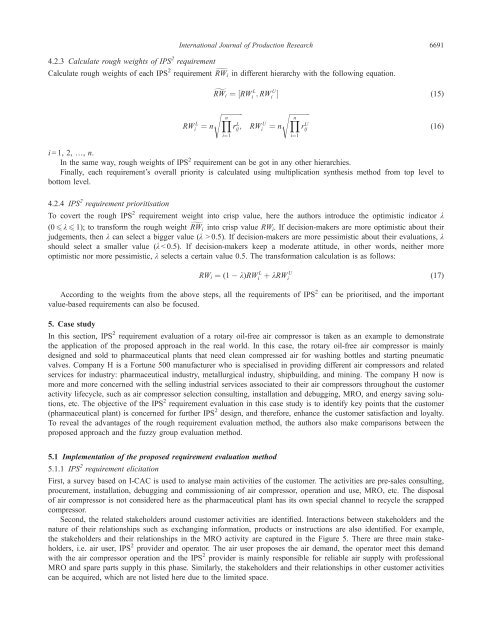A rough set approach for evaluating vague customer requirement of industrial product-service system_Wenyan Songa
You also want an ePaper? Increase the reach of your titles
YUMPU automatically turns print PDFs into web optimized ePapers that Google loves.
International Journal <strong>of</strong> Production Research 6691<br />
4.2.3 Calculate <strong>rough</strong> weights <strong>of</strong> IPS 2 <strong>requirement</strong><br />
Calculate <strong>rough</strong> weights <strong>of</strong> each IPS 2 <strong>requirement</strong> gRW i in different hierarchy with the following equation.<br />
gRW i ¼½RW L<br />
i<br />
; RW U<br />
i<br />
Š (15)<br />
RW L<br />
i<br />
¼ n<br />
sffiffiffiffiffiffiffiffiffiffiffiffi<br />
Y n<br />
i¼1<br />
r L ij;<br />
RW U<br />
i<br />
¼ n<br />
sffiffiffiffiffiffiffiffiffiffiffiffi<br />
Y n<br />
i¼1<br />
r U ij<br />
(16)<br />
i =1, 2, …, n.<br />
In the same way, <strong>rough</strong> weights <strong>of</strong> IPS 2 <strong>requirement</strong> can be got in any other hierarchies.<br />
Finally, each <strong>requirement</strong>’s overall priority is calculated using multiplication synthesis method from top level to<br />
bottom level.<br />
4.2.4 IPS 2 <strong>requirement</strong> prioritisation<br />
To covert the <strong>rough</strong> IPS 2 <strong>requirement</strong> weight into crisp value, here the authors introduce the optimistic indicator λ<br />
(0 6 λ 6 1); to trans<strong>for</strong>m the <strong>rough</strong> weight gRW i into crisp value RW i . If decision-makers are more optimistic about their<br />
judgements, then λ can select a bigger value (λ > 0.5). If decision-makers are more pessimistic about their evaluations, λ<br />
should select a smaller value (λ < 0.5). If decision-makers keep a moderate attitude, in other words, neither more<br />
optimistic nor more pessimistic, λ selects a certain value 0.5. The trans<strong>for</strong>mation calculation is as follows:<br />
RW i ¼ (1<br />
k)RW L<br />
i<br />
þ kRW U<br />
i<br />
(17)<br />
According to the weights from the above steps, all the <strong>requirement</strong>s <strong>of</strong> IPS 2 can be prioritised, and the important<br />
value-based <strong>requirement</strong>s can also be focused.<br />
5. Case study<br />
In this section, IPS 2 <strong>requirement</strong> evaluation <strong>of</strong> a rotary oil-free air compressor is taken as an example to demonstrate<br />
the application <strong>of</strong> the proposed <strong>approach</strong> in the real world. In this case, the rotary oil-free air compressor is mainly<br />
designed and sold to pharmaceutical plants that need clean compressed air <strong>for</strong> washing bottles and starting pneumatic<br />
valves. Company H is a Fortune 500 manufacturer who is specialised in providing different air compressors and related<br />
<strong>service</strong>s <strong>for</strong> industry: pharmaceutical industry, metallurgical industry, shipbuilding, and mining. The company H now is<br />
more and more concerned with the selling <strong>industrial</strong> <strong>service</strong>s associated to their air compressors th<strong>rough</strong>out the <strong>customer</strong><br />
activity lifecycle, such as air compressor selection consulting, installation and debugging, MRO, and energy saving solutions,<br />
etc. The objective <strong>of</strong> the IPS 2 <strong>requirement</strong> evaluation in this case study is to identify key points that the <strong>customer</strong><br />
(pharmaceutical plant) is concerned <strong>for</strong> further IPS 2 design, and there<strong>for</strong>e, enhance the <strong>customer</strong> satisfaction and loyalty.<br />
To reveal the advantages <strong>of</strong> the <strong>rough</strong> <strong>requirement</strong> evaluation method, the authors also make comparisons between the<br />
proposed <strong>approach</strong> and the fuzzy group evaluation method.<br />
5.1 Implementation <strong>of</strong> the proposed <strong>requirement</strong> evaluation method<br />
5.1.1 IPS 2 <strong>requirement</strong> elicitation<br />
First, a survey based on I-CAC is used to analyse main activities <strong>of</strong> the <strong>customer</strong>. The activities are pre-sales consulting,<br />
procurement, installation, debugging and commissioning <strong>of</strong> air compressor, operation and use, MRO, etc. The disposal<br />
<strong>of</strong> air compressor is not considered here as the pharmaceutical plant has its own special channel to recycle the scrapped<br />
compressor.<br />
Second, the related stakeholders around <strong>customer</strong> activities are identified. Interactions between stakeholders and the<br />
nature <strong>of</strong> their relationships such as exchanging in<strong>for</strong>mation, <strong>product</strong>s or instructions are also identified. For example,<br />
the stakeholders and their relationships in the MRO activity are captured in the Figure 5. There are three main stakeholders,<br />
i.e. air user, IPS 2 provider and operator. The air user proposes the air demand, the operator meet this demand<br />
with the air compressor operation and the IPS 2 provider is mainly responsible <strong>for</strong> reliable air supply with pr<strong>of</strong>essional<br />
MRO and spare parts supply in this phase. Similarly, the stakeholders and their relationships in other <strong>customer</strong> activities<br />
can be acquired, which are not listed here due to the limited space.



